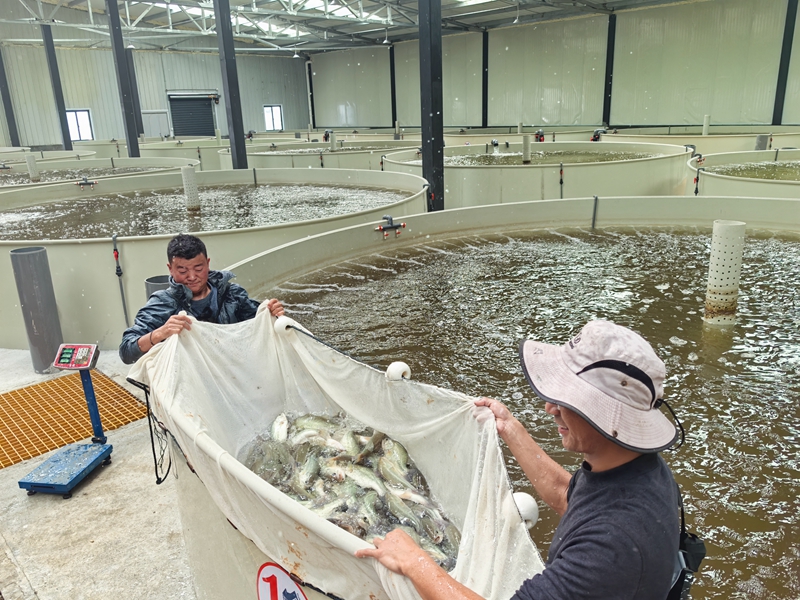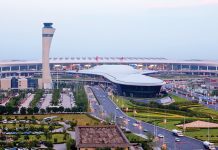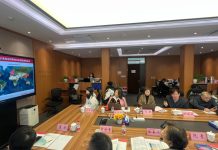
Fresh fish was the best-selling product in Xitun Supermarket in Nyingchi City, Xizang Autonomous Region, in the second half of 2024. “They were really fresh and usually sold out within half an hour,” He Mei, manager of the supermarket, said. The fish were raised by a local aquaculture farm, Nyingchi Statefarm Karma Agriculture Co. Ltd. (NSKA).
During the same period, the farm provided nearly 50 tons of locally cultivated fish and shrimp to different cities in the region, diversifying the diets of people living in Xizang. “That was the largest supply of locally-cultivated aquatic products ever seen in Xizang,” Luo Mingfei, Deputy General Manager of NSKA, told Beijing Review.
NSKA is located at the confluence of the Yarlung Zangpo and Nyang rivers in Mainling City, Nyingchi in south Xizang. It is one of the four state-owned farms in the region. Founded in 1960, the farm has been a leading fruit grower and a trailblazer of plateau agriculture in the region. Aquaculture is one of the company’s latest steps in achieving high-quality development in recent years.
Greenhouse fish farming
Luo, a senior aquaculture expert from Guangdong Province, arrived in Mainling City in July 2022 as part of a Central Government program to assist in the autonomous region’s development. In 1994, the Central Government introduced a policy to provide greater support to Xizang. Some developed provinces were asked to pair up with specific cities and counties in Xizang and provide assistance in areas such as infrastructure development, agriculture, healthcare and education. Guangdong and Fujian provinces have paired up with Nyingchi since then. Officials, doctors, experts and technicians from these two provinces volunteer to work in Nyingchi for a term of one to three years.
Guangdong is a coastal province and has a big aquaculture industry. According to the 2024 China Fisheries Statistical Yearbook, the province’s total annual output of aquatic products amounted to 9.24 million tons in 2023, ranking first in the country. In 2017, Ministry of Agriculture and Rural Affairs issued a plan to develop aquaculture in both Xizang and Xinjiang Uygur Autonomous Region. Officials from Guangdong who work in Nyingchi have therefore been exploring the possibility of aquaculture on the plateau since then. However, things did not initially go very well due to the lack of a skilled and experienced workforce.
There has long been a public perception that Tibetans do not eat fish because of their tradition of water burial and that the harsh plateau environment is not suitable for aquaculture. After arriving in Nyingchi in the summer of 2022, Luo and his colleagues conducted a field investigation, talking to both Tibetan culture experts and ordinary people living in the region and visiting local restaurants and wet markets in multiple cities.
They found that some Tibetans do not eat fish, while others have no objection to it. Among the 3.66 million permanent residents of Xizang, over 510,000 are non-Tibetans, who have a demand for fresh aquatic products. Also, Xizang is a popular destination and received 55.17 million visits in 2023. Tourists and workers from outside Xizang also create a huge demand for fresh fish and shrimp. “It’s estimated that consumers in Xizang consume about 4,000 to 5,000 tons of aquatic products every year. However, the annual local production is about 100 tons,” Luo said. Consequently, most aquatic products were transported to Xizang by air or land, with prices generally being one to two times higher than those in other places, he added.
With support from the Guangdong Agricultural Technology Promotion Center and the Zhuhai Modern Agricultural Development Center, aquaculture experts found that Mainling, with an average altitude of 2,860 meters, has abundant cold water and ample sunshine. Such an environment is suitable for breeding Chinese Ayu, a cold-water fish with a short growth cycle.
In the spring of 2023, Guangdong experts and local technicians worked together to establish an aquaculture operation from scratch, building tanks, setting up greenhouses and introducing fish fry from Guangdong.
To maintain the appropriate water temperature, they created a tailored greenhouse that has a plastic cover and base, which function like the two shells of a clam, enclosing ponds within it. The shells help maintain adequate water temperature for fish growth. The first batch of fry from Guangdong arrived in Nyingchi in April 2023. After five days, over 95 percent of the fry survived the high altitude, exhibiting strong adaptability.
However, not all fish farming stories on the plateau have ended so happily. Initially, the farm shared some of the water channels with upstream farmers. One night, a sudden downpour caused upstream farmers to release water, and the temperature in the farm’s tanks plummeted. In just one night, all the fish in the tanks died. After that, dedicated water storage ponds were built and a modern aquaculture monitoring system was introduced. “Failures have driven us to continue updating our hardware facilities and management systems,” Luo said.
After eight months of effort, the farm produced and sold its first batch of greenhouse-grown fish, generating a revenue of nearly 300,000 yuan ($41,117) at the end of 2023.
The success encouraged them to try growing other species, including South American shrimp, in the following year. To enable shrimp to absorb sufficient minerals from the water, they have developed an “artificial seawater” suitable for shrimp farming. Also, they shortened the growth cycles with the help of heating and insulation technologies. In July 2024, the farm’s fresh mature shrimp and eight kinds of fish were available on the regional market, bringing down the local price of aquatic products by 20 to 30 percent, according to Luo. “It’s expected that we can farm 200 tons of aquatic products and 3 million fry in 2025, with yearly earnings of over 8 million yuan ($1.1 million),” he added.
“Mass production of aquaculture in Xizang not only enriches the local residents’ diets but also helps many locals increase their incomes. This industrial model is suitable for promotion within the region,” Zhou Jianshe, associate researcher at the Institute of Aquatic Research of the Xizang Academy of Agriculture and Animal Husbandry Sciences, said.
Talent and innovation
Luo’s term in Xizang will conclude in the summer of 2025. Racing against the time to cultivate a local technician team is his biggest mission. He now has several Tibetan apprentices, including Nyima Wangdu. He is a third-generation employee working on the farm. Graduating from a university in Hunan in 2018, he is now the deputy director of the farm’s Production Technology Department.
The farm now aims to become a modern fisheries park with innovative technologies. So far, it has six national-level patents related to plateau fish farming. With additional funding of 24.25 million yuan ($3.3 million), the farm is planning to enlarge its current aquaculture operations by 50 percent, becoming an 8-hectare plateau aquaculture science and technology park in the coming years.
Tie Ding, Director of the Agricultural Research Center of Yuanyi Think Tank, said that although plateau aquaculture faces many challenges, it also offers opportunities. It facilitates cross-regional agricultural technology collaboration and serves as a model for innovative applications of agricultural modernization. –The Daily Mail-Beijing Review news exchange item





